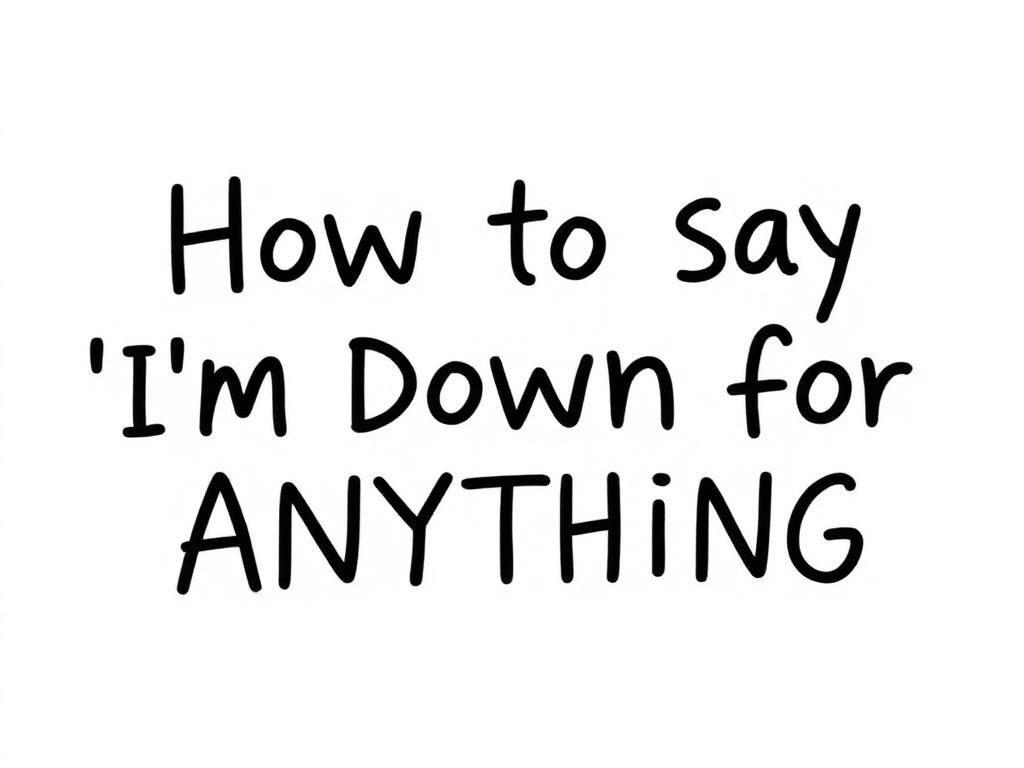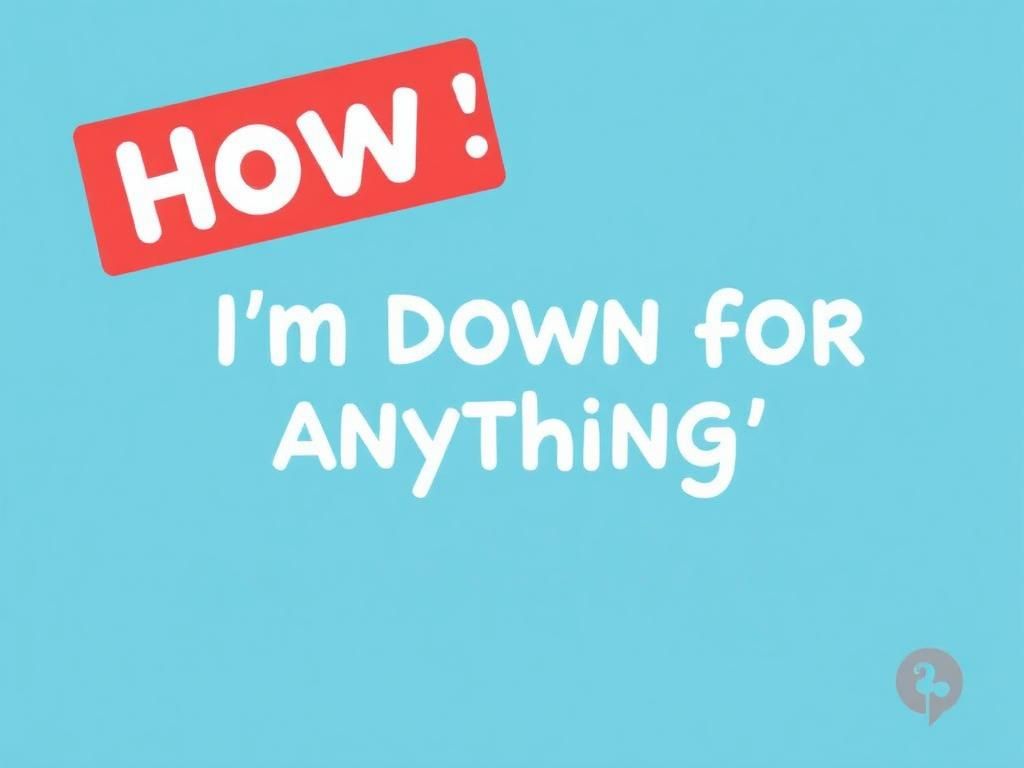Expressing flexibility and openness is crucial in various contexts, from professional settings to social engagements. The casual phrase, “I’m down for anything,” may not always convey the level of professionalism or seriousness required. By adopting a more formal approach, you can enhance your communication and leave a better impression. This article aims to provide you with comprehensive alternatives and practical tips on how to say “I’m down for anything” formally.

Understanding the Context
When to Use Formal Language
Different situations demand varying degrees of formality in communication. Recognizing the appropriate context for formal language is essential for effective interaction:
- Professional settings: Whether you’re in the workplace, during meetings, or at conferences, formal language can help maintain professionalism.
- Academic environments: In classrooms or seminars, using formal expressions can enhance your credibility and respect among peers and instructors.
- Social situations: At formal events or gatherings, adopting a more refined vocabulary can help you connect appropriately with others.
Why Formality Matters
Using formal language serves several important purposes:
- Demonstrates professionalism: Formal expressions convey respect and seriousness, establishing a positive impression.
- Establishes clearer communication: Formal language reduces ambiguity, making it easier for others to interpret your intentions accurately.
- Avoids misunderstandings: By using formal alternatives, you minimize the risk of being misinterpreted, especially in crucial discussions.
Formal Alternatives to “I’m Down for Anything”
Suggestions for Verbal Communication
When conversing, consider these formal alternatives:
- “I am open to any suggestions.” This phrase clearly indicates your willingness to consider different ideas.
- “I am available for any activities you propose.” It emphasizes that you are flexible and ready to engage.
- “I would be pleased to participate in whatever you have in mind.” This showcases enthusiasm and readiness to collaborate.
Suggestions for Written Communication
In written exchanges, these formal phrases can be quite effective:
- “I look forward to your recommendations.” This statement expresses eagerness to hear others’ ideas.
- “I am open to exploring various options.” It conveys a willingness to consider multiple possibilities.
- “Please feel free to suggest any activities you deem fitting.” This phrase invites suggestions while maintaining a formal tone.
Tailoring Your Language to the Audience
Assessing the Audience’s Preferences
Understanding your audience is vital when formulating your message:
- Understanding the level of formality required: Different audiences may expect varying levels of formality. Tailor your language accordingly.
- Considering cultural differences in communication: Communication norms vary across cultures. Being considerate of these differences can improve your interactions.
Examples of Situational Adaptations
It’s essential to adapt your expression based on the situation:
- Workplace vs. professional networking event: In a workplace setting, you might say, “I am available for any projects.” At a networking event, you could opt for, “I welcome any collaborative opportunities.”
- Formal dinner invitations vs. business meetings: For a dinner invitation, you might express, “I would be delighted to join.” In a meeting, you could state, “I am prepared to contribute to any agenda items.”
Enhancing Your Expression of Openness
Adding Enthusiasm
To enhance your expression of openness, infuse your statements with enthusiasm:
- “I would be delighted to…” creates excitement about participating.
- “I am excited about the possibility of…” conveys passion and eagerness to engage.
Offering Options
Proactively offering options can demonstrate flexibility:
- “I am flexible and can adjust to what works best for the group.” shows willingness to accommodate others’ preferences.
- “I can accommodate any proposals that align with my schedule.” indicates readiness to make arrangements.
Practice Scenarios
Sample Dialogues
Practice scenarios can help you gain confidence using formal expressions:
- Workplace setting: When a colleague invites you to brainstorm, you might respond, “I am available for any brainstorming sessions you schedule.”
- Academic setting: While engaging in class discussions about group projects, you could say, “I am open to any ideas you wish to present.”
Self-Reflection Questions
Reflecting on your communication style can facilitate growth:
- How comfortable are you in expressing flexibility in formal settings? Regular self-assessment can enhance your communication skills.
- Which phrases resonate best with your communication style? Identify phrases that feel authentic while still being formal.
Conclusion
Utilizing formal language to convey flexibility is both valuable and necessary in various contexts. Regular practice with different phrases can enhance your communication skills and build stronger professional relationships. Share your experiences and additional effective phrases with others to inspire collective growth.
Frequently Asked Questions
1. Why is it important to express flexibility formally?
Expressing flexibility formally enhances professionalism and clarity in communication, which is vital in business and academic settings.
2. How can I improve my formal communication skills?
Practice using formal language in different contexts, engage in public speaking, and consider taking courses in professional communication.
3. Are there cultures where formal communication is less important?
Yes, some cultures prioritize casual communication. It’s important to understand cultural nuances when communicating.
4. Can informal language be effective sometimes?
Informal language can create a relaxed atmosphere but may not be appropriate in all settings, especially professional ones.
5. What are some common mistakes people make in formal communication?
Common mistakes include using overly complex vocabulary, being vague, or failing to adapt language to the audience or context.
6. How can I assess my audience’s communication style?
Observe their language use, ask questions about preferences, and note the formality of previous interactions.
7. Is it advisable to ask for feedback on my communication style?
Absolutely! Feedback can provide valuable insights into how your communication is received by others.
8. What type of phrases should I avoid when aiming for formal communication?
Avoid slang, overly casual expressions, and ambiguous language to maintain a formal tone.
9. How can I make my formal communication sound natural?
Practice speaking and writing with formal phrases until they become second nature, while still allowing your personality to shine through.
10. Where can I find resources to improve my formal communication skills?
Explore books on professional communication, join courses for public speaking, and check websites dedicated to language learning such as Toastmasters or Khan Academy.
| Communication Context | Casual Phrase | Formal Alternative |
|---|---|---|
| Workplace | I’m down for anything | I am open to any suggestions. |
| Academic | I’m down for anything | I am available for any activities you propose. |
| Social | I’m down for anything | I would be pleased to participate in whatever you have in mind. |
Additional Resources
Tips for Effective Communication
Explore books on professional communication and consider taking courses on public speaking and formal writing to enhance your skills.
Websites for Language Learning
Check out online resources for improving business communication skills and forums discussing formal expression in various contexts.


